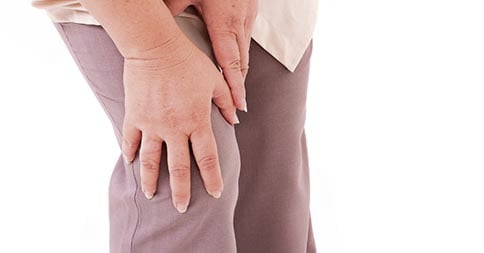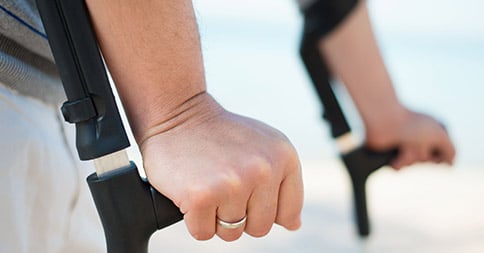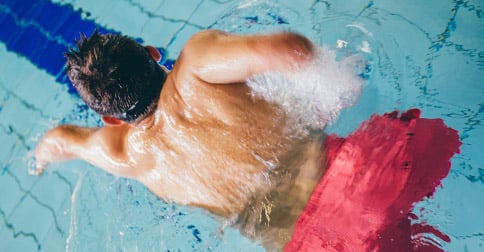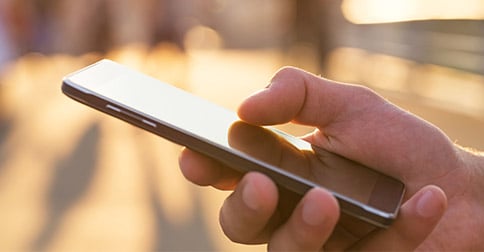Aging will always bring new challenges to life and make simple things harder to accomplish. With each new year, there are new things to consider. This is even more true for those who have experienced limb loss. Certain tasks are already more difficult to perform with a prosthesis, and growing older will not make them easier. There will also be new difficulties that you may not have thought of, but they are not impossible to deal with. Let’s look at some potential problems and ways to handle them that can allow your life to be full of possibilities at any age!
Health
As the body ages, certain parts of our health will become more complicated. Even the healthiest of people will experience symptoms beyond their control. We can take steps to treat them, though! One of the major health concerns with age is arthritis, and those with a prosthesis are unfortunately more likely to experience it in their spine, hips, and complete limbs. Staying healthy and active is the best way to slow down the process, and is great for overall health in general. If arthritis does become a serious concern, it is very important to talk to your prosthetist about using a new prosthesis that is easier to wear and can handle more weight.
Weight gain and vascular diseases are also symptoms for many people entering old age. These require the same adjustment as arthritis: staying healthy and working with your prosthetist to keep adjusting your prosthesis. Taking care of yourself and staying ahead of the problem can do wonders for the body.
Adjustments
Two of the biggest adjustments with growing older will be related to balance and taking care of your skin. Balance becomes an issue with age, regardless of previous health. Adjustment to your prosthesis and wearing appropriate footwear are the best methods to combat this. Those with limb loss deal with skin care their entire lives, but it becomes more difficult with age. Stay ahead of the issue through using specialty soaps and socks to keep your skin protected.
Medical Care
While it’s not the most fun topic, insurance is important to discuss before you reach a point where you plan doesn’t cover something you need. Understand your policy and how it could be affected and plan ahead. It may feel out of your control at times, but being prepared can do a lot.
We Know the Industry
BioTech has been working in the industry for over 15 years. We have worked with people of all ages and medical backgrounds. Our number-one priority is making sure that YOU have everything you need to live as comfortably as possible. Contact us today to see how we can help guide and provide the best knowledge and equipment for growing older.
Climbing Mt. Everest and reaching the summit is a task that only a select few can say they have accomplished. A miniscule amount of climbers can even make the journey to the base camp, and even the ones fortunate enough to get the opportunity don’t always make it to the top. It is a dangerous mission that is only meant for those who are both mentally and physically strong.
Tom Whittaker is one of those people.
Tom Whittaker lost his right foot after a car accident in 1979. He had already been physically active (he was a rock climber, rugby player, and had already summited Mount McKinley) before the wreck and decided to keep this mentality after. Along with regular workouts, he found which muscles to train that would offset the loss of his right leg and began to acquire a new form of balance. Training to hike any mountain is never easy, but climbing Mt. Everest with a prosthesis had literally never been done before. It would take new levels of determination and strength to reach the top.
Tom had two trips that were cut short before his historical ascent to glory in 1998. The first was in 1989 when he had almost reached 25,000 feet. A storm arrived and killed a total of six people. He would not get another attempt at the summit until 1995, when he almost reached the top. With only 1,500 feet remaining, Tom felt that he was moving too slowly on the rocks to make it to camp by nightfall and had to turn away from his decades-long goal. A friend and member of his crew brought him back a rock from the summit during that trip and told Whittaker to return it to the top for him.
Tom finally reached the summit of Mt. Everest on May 27th, 1998, and carved his name in history in that moment. His wife, Cindy, was there every step of the way, leading the crew into the Everest base camp and managing the monumental Everest Challenge ‘98. Tom Whittaker is not only a pioneer in prosthetic achievements, he should be an example of the truth that anything can be done, no matter what those around you say. It will not always be easy; in fact it will usually be difficult, but whatever challenge we are facing with a prosthesis or otherwise, we know we will be able to move past it.
BioTech Is Here to Help
We exist not only to provide you with the prosthesis and other equipment needed to feel comfortable daily, but to excel at whatever it is you want to accomplish. Our team has years of experience and enjoys seeing the people we work with continue to succeed. Contact us today to learn more about how we can help you move your mountain.
Memorial Day is almost here, and with it comes the remembrance and honoring of every soldier that has died in battle. While we are remembering those that are gone, we can still take steps toward helping our nation’s living veterans. Here are a few ways we can honor the deceased while thinking of the living.
Fly Flags at Half-Mast
The United States flag is typically flown at half-mast until noon on Memorial Day. This is done to give honor and thanks to our fallen heroes. If you have a flagpole, take time to research the proper way to carry and raise the flag, and inform those around you if they would like to become involved. Even if you don’t have a flagpole, take some time when you pass a flag to remember everything others have sacrificed and given up for us to be here.
Donate to Charity
Donating to a charity for veterans can help the quality of life for veterans who gave up so much of themselves for our freedom. Memorial Day is focused on those who gave their life, but it is also a great reminder of what has been given up by veterans and their families. Many members of our military have endured physical limb loss, not to mention the mental and emotional toll of battle. Look into the thousands of charities available and find one that you would like to donate to.
Visit a Museum
Museums are a great way of understanding the brutal conditions that soldiers face in war. If you have children that seem to take these days lightly, showing them just how much was given up for their freedom may help them gain an appreciation for our fallen heros.
Thank Living Veterans and Soldiers
It is easy to be viewed as a hero once you have passed, but many of our living veterans do not get the support, help, and thanks that they deserve. Besides donating to a charity or volunteering to help disabled veterans, saying thank you to a veteran or active soldier can go a long way. Care packages can show that you do indeed care, and something as small as a conversation can help show that we do appreciate everything that they have done for us.
BioTech Thanks All Those Who Have Fought
BioTech has worked with many veterans and is thankful for every citizen that puts on a uniform to defend our country. This Memorial Day, we want to remember all the veterans lost in battle, and we vow to continue helping those who have lost a limb in war. Learn more about what we do and contact us today to discuss finding the right prosthesis for you.
Armed Forces Day is Saturday, May 20. The annual event is part of Armed Forces Week, which starts on the second Saturday of May every year. The intention of the week is to pay our respect to all of the men and women who have served for the United States Armed Forces. All branches are recognized and honored on this day. It is the perfect time to focus on and appreciate everything that veterans have sacrificed for our freedom - including, sometimes, their limbs.
The harsh reality of war is readily faced by our brave soldiers, and unfortunately, some of our best citizens are put in rough situations. Thousands of veterans lost a limb in combat or as a result of an amputation after being in Iraq and Afghanistan alone.
Solutions
Fortunately, we are in a time where we can make life as comfortable as possible for those who have suffered limb loss, including our veterans. New technology is constantly being invented which not only makes everyday life easier, but also advances a wide range of interests including athletics and exercise. Prosthetic devices are being made more customizable and comfortable, and continue to improve.
Besides the physical conflicts, many veterans are faced with mental conflicts like PTSD after coming back from battle. There are many treatment centers, group therapies, and psychologists that can assist in moving past this. If you or someone you know seems to be feeling symptoms, it is important to seek help as soon as possible. Keep these organizations that aim to help veterans with limb loss in mind.
Saying Thank You
Armed Forces Day reminds us to thank our veterans, but we should carry that reminder with us throughout the year. Both through words and actions, there are many ways to says thanks. There are programs for anything you can imagine. Writing thank-you notes to veterans or current soldiers, donating money to help veterans receive a prosthesis, visiting a VA, and countless other appreciative actions are possible through selfless people starting organizations. If you personally know a veteran, take the time to say thank you throughout the year.
We Thank You
BioTech has had the fortune to work with many different heroes, and we are thankful for everyone who has fought for our country. If you are in need of a prosthesis and interested in finding the best path for you, contact us today.
The Grand Slam Tennis Tournament is about to enter its second stage at the Roland Garros in Paris. After that, it will proceed to New York City for the US Open. While we watch these great players perform, we can also spend some time playing ourselves--even if we’ve experienced limb loss.
Fortunately, playing tennis with a prosthetic leg is fairly easy to do. Whether you are playing competitively or just hitting the ball around with friends, learn how to stay comfortable while playing and find out the right equipment to use.
Why Tennis?
Tennis is a perfect activity for someone who has experienced limb loss and is trying to become more active. You obviously need to feel comfortable being active in your prosthesis already, but playing tennis will help you handle turns, short sprints, and pivots while allowing you to enjoy yourself at the same time.
You can also play at the speed you choose, whether it’s soft lobs back and forth with a friend or a more competitive speed round. Start slow, get acquainted, and see if this is the sport for you. For those who enjoy it, there are tennis clubs across the country that you can play in, and specialized camps for those looking to play other adaptive tennis players.
Preparing
As we said earlier, a large positive of playing tennis is the ability to choose your own pace. The quality of your equipment will change as you become a more active player. Some ways you can help yourself adjust to being more physically active are frequently exercising your core, discussing the parts of your prosthesis with your specialist, and joining a group to motivate you to continue playing. Practice moving in a controlled environment to get adjusted to your equipment and make sure it fits well for physical activity.
Equipment
Fortunately, we live in a time where technology for limb loss is improving every day. Talk to your prosthetist and let them know what you are trying to accomplish, and they will help you find the right fit for you. There is a wide range of athletic prosthetics available, and it is important to match the one that fits you and your goals the best. If you get a new prosthesis, it is important to wear it in for a bit before using it competitively.
Let BioTech Help!
BioTech specializes in using the best and most up-to-date technology to make your everyday life as simple as possible. This includes hobbies and sports like tennis. We want to make sure you have the most comfortable and quality prosthesis, and we will work with you to make sure you achieve everything you want to accomplish. Contact us for more information.
There are many concerns when dealing with pregnancy, and having a prosthesis can add a couple more. While many people go through this particular situation, there is not an excess of information available about it -- so we wanted to provide some answers. Read on!
Pregnancy
A major concern is your prosthesis fitting properly as you gain weight later in the pregnancy. This can lead to a tight socket, which causes sores and cuts. It is important to meet with your prosthetist to discuss the best option for you.
Having a socket made of flexible material, like the BioTech Comfort Socket System, that can adapt to your body throughout the pregnancy is crucial and should be a top priority. If you have a hard time finding this or you are not comfortable in your socket, talk to your prosthetist about getting a larger socket. It may be a bit too big at first, but find one that you will grow into later in the pregnancy. In some situations, you may not feel comfortable wearing your prosthesis in the last few months. If this happens, then crutches or a wheelchair can be used for transportation.
Childbirth
Preparing for the actual moment of childbirth can feel overwhelming, but it is important to remember to stay calm and collected. You can choose whether or not to wear your prosthesis. Many people choose not to so as to keep their prosthesis and liner clean, but you should do whatever makes you feel more relaxed.
You can always clean your prosthesis afterwards, if that is what feels best. If you are worried about your residual limb being in pain or a doctor/nurse accidentally hitting a sensitive spot, ask to have a loved one hold your leg. If they do not already know your sensitive areas, make sure to communicate with them before.
Motherhood
Becoming a parent while having a prosthesis can be nerve-wracking at times. Baths, car rides, and changing diapers can be overly difficult if you are not prepared. It helps to get creative with the supplies around you. While changing diapers, for example, find a way to keep your child’s feet up. This could be with cloth or another device that allows you to focus on the cleaning and changing process. When it comes to baths, it may help to find a specialized chair that allows the baby to sit in the water while you wash.
Let BioTech Help You Prepare!
If you are nervous about your pregnancy and parenthood, let us know and we will help find the right equipment and classes for you. This is an exciting time, and while being prepared is important, you must remember that you have the support and strength to excel and begin raising your family! Contact us today for more information.
We’re thrilled about observing Limb Loss Awareness Month 2017, and we’re ready to help make it the best one yet! Keep reading below to find out how you can be a part of this very exciting month.
Hill Day
Come to Washington, D.C. from April 25-26 and talk to your elected officials about issues that have an effect on those with limb loss. Training and networking starts at noon on the 25th, and legislator visitation takes place on the 26th. Among other things, we’ll be addressing insurance fairness for amputees, funding for programs and research that improves life for someone with limb loss, and more. Get more details here.
Harness the Power of Social Media
We all know social media can be an incredibly effective tool for spreading the word about… well, anything. Download the Amputee Coalition toolkit and dedicate your social network pages to Limb Loss Awareness Month! With premade graphics, flyers, and more, you’ll have everything you need to make sure all your friends know how special this month is.
Show Your Mettle
Definitely one of the most loved traditions of LLAM, this is a great opportunity to show exactly what you’re made of!
Step 1: Take a photo of yourself that showcases your limb loss.
Step 2: Post it with the hashtag #ShowYourMettle, and let your unstoppable spirit shine!
Book a Speaking Engagement
Whether at your local library, civic group, or church, April is a great month to speak about limb loss and everything it entails. Reach out to organizations around your city and ask them if they’d be interested in having you come speak. Then, use that opportunity to educate the public about limb loss and encourage them to get involved with their elected officials to help amputees live well!
Need More Tips for Limb Loss Awareness Month?
If you’re looking to get involved but you’re not sure how to take the first step, contact BioTech. We love our patients like family, and we’ll do anything to make sure they are loved and celebrated during the month of April (and every other month, for that matter). Contact us today for more information on limb loss, prosthetic devices, and more!
If you’re headed to the beach for the first time after limb loss, you may be wondering if there are certain things you should and shouldn’t do regarding your prosthetic device. The short answer is, yes – there are definitely special considerations to be made as an amputee at the beach! Read on to learn some tips for a beach trip that’s safe and fun.
Tip #1: Don’t Leave Your Prosthesis in the Car
If you’re driving from your condo to the beach access point, you may be tempted to just leave your prosthesis in the backseat for safekeeping. However, a prosthesis that’s left in a car can get too hot, which can cause the plastic to melt and warp. You don’t want that!
Tip #2: Know How to Use a Prosthesis in the Water
First of all, there are some prostheses that are actually designed to be used in water. After you use one, though, be sure you turn it upside down when you rinse it out because sand and water can get trapped inside. There are also protective covers that you can use on your regular prosthesis to keep it dry, even when it’s completely submerged.
Also, another tip: some prosthetic devices float in the water!
Tip #3: Be Careful with Forearm Crutches
If you’re using forearm crutches at the beach, be aware that they are hollow and can easily fill up with sand and/or water. Also, if part of your crutches are metal ( this really goes for all prosthetic devices), then remember the danger of rust. If your device is exposed to salt water, you need to rinse and dry them well so that they don’t rust.
Let BioTech Help You Recognize Your Possibilities!
We’re committed to helping all of our patients live full, exciting, adventurous lives – and that includes you! If you’re looking for a prosthetist who will help you with everything from the fit of your prosthesis to getting back to your old hobbies, look no further than BioTech. Contact us today to learn more!
After you lose a limb, you may feel like all the goals you had set for yourself are no longer viable. The truth, though, is that there’s usually a way to continue with your passions and dreams, even after an amputation. Read on!
Goal Adaptation
Let’s say your goal was to climb Mount Everest this year, but now you’re a double leg amputee and you feel like the dream is impossible. Maybe, instead of giving up altogether, you adapt your goal to fit your new situation.
Instead of climbing Mount Everest this year, give yourself a few years to get more comfortable with leg prostheses and work your way up to Mount Everest. Start with a small mountain and see how it goes. Then try a slightly larger one. Always keep a friend or two with you, and make sure you have all the necessary gear to do this successfully – and before you know it, you’ll be tackling your dream mountain as a double amputee!
New Goals
Limb loss actually opens up a whole new world of potential goals. Now, whatever you do, you’ll be doing it as an amputee – and you’ll be amazed at how much you can accomplish and how many people admire your persistence.
If your former goal seems too unlikely now, or you’re just not feeling inspired by it anymore, who says you can’t pick a new one? Take up something that interests you and feels more manageable, and then come back to your old goal in the future if you decide you want to!
Former Impossibilities Are Now Possible!
Always wanted to be a motivational speaker, but you never had a platform? Now you do! Consider all the things you weren’t a good candidate for before your limb loss, and then think about whether your amputation has changed that. People who overcome great challenges have lots of opportunities for speaking engagements, school involvement, and even new career paths.
Once you start recognizing all your possibilities, you’ll be setting and achieving goals in no time!
Need Advice for Setting Goals after Limb Loss? Call BioTech!
We love our patients like family – and that means we’re always here to talk, listen, or offer advice. Contact us today for more information on our services and how we can help you reach the stars!
Smartphones have a way of making our lives a little easier (well, except when they decide not to work correctly), and that’s also true for people with limb loss. When you’re trying to get back into some kind of routine, it can be helpful to have a handy app on your side, making the road to recovery just a little bit smoother.
Take a look at these apps for people with limb loss, and search for them in your phone’s app store!
Fitness for Amputees
This app calls itself “your portable personal fitness trainer” and offers exercises that are easy to understand, with video examples, that have been developed by an Ottobock physiotherapist. With 3 levels to progress through, this app should be useful for you for a while.
Here at BioTech, we believe that exercise is an essential part of recovery after limb loss. That’s why we think any app that encourages you to challenge yourself and reach your goals is great! If you need a starting point, check out this app, and see if it’s something that appeals to you.
Amputee Coalition inMotion
inMotion Magazine, published 6 times per year, is made especially for people with limb loss and their families. It provides timely, essential information on living with limb loss, and seeks to empower those who’ve become amputees.
So why do we think a magazine app is useful? Because it encourages things we believe in: community, education, and possibilities. When you’re reading about other people with limb loss, and the possibilities you can recognize when you’re inspired by other people, it can do a lot for your mental and emotional state. So we think this app is a great option!
Need More Resources? Contact Us Today!
One of our favorite things about what we do is working with patients – encouraging them, helping them get a great fit with their prosthesis, and giving them the tools they need to find a sense of normalcy. If you are in need of resources like this, please contact us today – we’re always ready to help!









